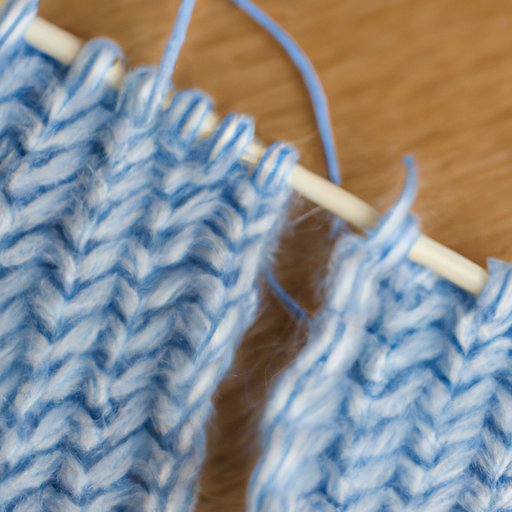Introduction
If you are a knitter, you understand the sense of accomplishment that comes with completing a project. But, before you can add your latest creation to your collection, there’s one crucial step that you need to get right – casting off. This process might seem a bit intimidating to beginners, or even seasoned knitters, but with the right guide and techniques, it can be effortless. This article aims to offer a comprehensive guide on the different casting off techniques to ensure you achieve the perfect finish.
The Step-by-Step Guide to Casting Off Your Knitting: A Beginner’s Tutorial
Casting off, also known as binding off, is the process of finishing the last row of knitting to prevent it from unravelling. As a beginner, it’s important to learn the essential technique that will help you perfect your stitching skills. Here’s a simple guide to help you get started:
1. Knit two stitches.
2. Insert the tip of the left needle into the first stitch you knit.
3. Lift it over the second stitch and off the right needle.
4. Knit another stitch and repeat steps 2 and 3 until the end of the row.
5. Cut the yarn, leaving a tail about 6 inches long.
6. Pull the end of the yarn through the final loop to tie it off.
Mastering the Bind Off: Tips and Tricks for Finishing Your Knitting Projects
It’s important to master the bind-off technique to achieve a neat finish in your knitting projects. A loose or tight bind off can affect the overall look of your project. Here are some tips and tricks to help you perfect the technique:
1. Keep your tension consistent throughout the row. Tightening or loosening the yarn can result in inconsistency in your bind off.
2. Use a larger needle size than the one you used for knitting for a looser bind-off.
3. To avoid tangling, ensure that the yarn tail you are using to bind off is not too long.
4. Re-arrange your stitches on the needle to create a better tension when binding off.
5. Do not pull too tightly as it can cause the final edge to become uneven.
Saying Goodbye to Your Yarn: Techniques for Casting Off Like a Pro
As an experienced knitter, you might want to experiment with more advanced techniques to achieve a more polished result. Here are a few techniques that you can try:
1. Lace Bind-Off: This method is ideal for projects that require a more extensive finish. It is done by creating decorative loops around the edge of the project.
2. Picot Bind-Off: This technique is perfect for creating decorative edgings on your projects. It involves knitting a stitch, then casting off a certain number of stitches to create a picot loop.
3. Three-Needle Bind-Off: This technique is useful for joining two pieces of knitting, creating a flat seam that is perfect for scarves and blankets.
4. I-Cord Bind-Off: This method creates a continuous tube-like cord. It’s perfect for creating straps and decorative details on projects.
5. Tubular Bind-Off: This technique is excellent for creating a two-sided edge with a clean finish. It’s useful for projects such as cuffs, hats, and socks.
The Importance of Casting Off Correctly: Avoiding Common Mistakes
Casting off incorrectly can cause problems with the finished project. Here are some common mistakes that knitters make when casting off and tips on how to avoid them:
1. Tight Binding: A tightly bound-off edge can cause your project to curl or become distorted. To avoid this, try a looser bind-off technique or use a larger needle size.
2. Uneven Edge: Uneven edges are often a result of inconsistency in tension. To prevent this, keep your tension consistent throughout the row.
3. Stretchy or Loose Bind: A stretchy bind-off can be good for projects such as socks, but it can also cause your project to become too loose in some areas. To avoid this, consider using a technique that is neither too loose nor too tight.
4. Uneven Binding-Off: Uneven binding-off can cause your project to look sloppy. To prevent this, ensure that you keep your stitches even when you bind off.
5. Too Short a Tail: Not leaving enough yarn at the end of your project can cause it to unravel. To avoid this, ensure that you leave a tail that is at least six inches long.
Top 5 Binding Off Methods to Give Your Knitting a Professional Finish
1. Lace Bind-Off: Ideal for delicate shawls and wraps.
2. Picot Bind-Off: Great for decorative edges, pillowcases, and shawls.
3. Three-Needle Bind-Off: Perfect for joining two pieces of knitting.
4. I-Cord Bind-Off: Ideal for finishing sleeves, sweater hems, and bag handles.
5. Tubular Bind-Off: Excellent for finishing circular pieces such as cuffs and socks.
Conclusion
Casting off is an essential element of knitting, and it’s crucial to perfect the technique to achieve a polished result. As a beginner, it’s important to follow the instructions carefully, while experienced knitters can experiment with more advanced techniques to create unique designs. By avoiding common mistakes such as uneven edges, tight binding-off, uneven binding, and too short a tail, you can achieve a professional finish in your knitting projects. So, grab your knitting needles and yarn, practice, and experiment with different casting off techniques to create beautiful and unique projects.
